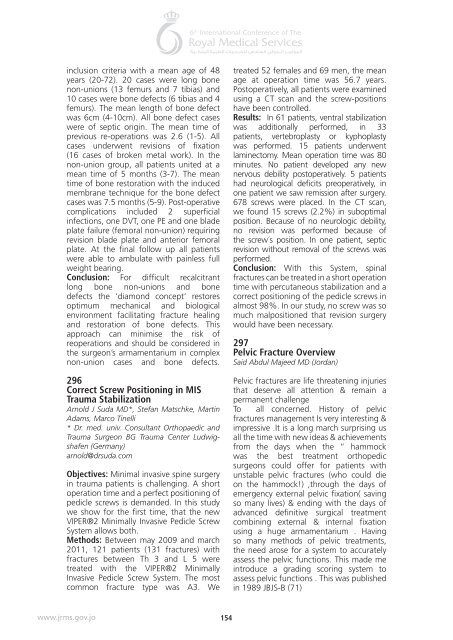Abstract book 6th RMS 16.indd
Abstract book 6th RMS 16.indd
Abstract book 6th RMS 16.indd
You also want an ePaper? Increase the reach of your titles
YUMPU automatically turns print PDFs into web optimized ePapers that Google loves.
inclusion criteria with a mean age of 48<br />
years (20-72). 20 cases were long bone<br />
non-unions (13 femurs and 7 tibias) and<br />
10 cases were bone defects (6 tibias and 4<br />
femurs). The mean length of bone defect<br />
was 6cm (4-10cm). All bone defect cases<br />
were of septic origin. The mean time of<br />
previous re-operations was 2.6 (1-5). All<br />
cases underwent revisions of fixation<br />
(16 cases of broken metal work). In the<br />
non-union group, all patients united at a<br />
mean time of 5 months (3-7). The mean<br />
time of bone restoration with the induced<br />
membrane technique for the bone defect<br />
cases was 7.5 months (5-9). Post-operative<br />
complications included 2 superficial<br />
infections, one DVT, one PE and one blade<br />
plate failure (femoral non-union) requiring<br />
revision blade plate and anterior femoral<br />
plate. At the final follow up all patients<br />
were able to ambulate with painless full<br />
weight bearing.<br />
Conclusion: For difficult recalcitrant<br />
long bone non-unions and bone<br />
defects the ‘diamond concept’ restores<br />
optimum mechanical and biological<br />
environment facilitating fracture healing<br />
and restoration of bone defects. This<br />
approach can minimise the risk of<br />
reoperations and should be considered in<br />
the surgeon’s armamentarium in complex<br />
non-union cases and bone defects.<br />
296<br />
Correct Screw Positioning in MIS<br />
Trauma Stabilization<br />
Arnold J Suda MD*, Stefan Matschke, Martin<br />
Adams, Marco Tinelli<br />
* Dr. med. univ. Consultant Orthopaedic and<br />
Trauma Surgeon BG Trauma Center Ludwigshafen<br />
(Germany)<br />
arnold@drsuda.com<br />
Objectives: Minimal invasive spine surgery<br />
in trauma patients is challenging. A short<br />
operation time and a perfect positioning of<br />
pedicle screws is demanded. In this study<br />
we show for the first time, that the new<br />
VIPER®2 Minimally Invasive Pedicle Screw<br />
System allows both.<br />
Methods: Between may 2009 and march<br />
2011, 121 patients (131 fractures) with<br />
fractures between Th 3 and L 5 were<br />
treated with the VIPER®2 Minimally<br />
Invasive Pedicle Screw System. The most<br />
common fracture type was A3. We<br />
treated 52 females and 69 men, the mean<br />
age at operation time was 56.7 years.<br />
Postoperatively, all patients were examined<br />
using a CT scan and the screw-positions<br />
have been controlled.<br />
Results: In 61 patients, ventral stabilization<br />
was additionally performed, in 33<br />
patients, vertebroplasty or kyphoplasty<br />
was performed. 15 patients underwent<br />
laminectomy. Mean operation time was 80<br />
minutes. No patient developed any new<br />
nervous debility postoperatively. 5 patients<br />
had neurological deficits preoperatively, in<br />
one patient we saw remission after surgery.<br />
678 screws were placed. In the CT scan,<br />
we found 15 screws (2.2%) in suboptimal<br />
position. Because of no neurologic debility,<br />
no revision was performed because of<br />
the screw´s position. In one patient, septic<br />
revision without removal of the screws was<br />
performed.<br />
Conclusion: With this System, spinal<br />
fractures can be treated in a short operation<br />
time with percutaneous stabilization and a<br />
correct positioning of the pedicle screws in<br />
almost 98%. In our study, no screw was so<br />
much malpositioned that revision surgery<br />
would have been necessary.<br />
297<br />
Pelvic Fracture Overview<br />
Said Abdul Majeed MD (Jordan)<br />
Pelvic fractures are life threatening injuries<br />
that deserve all attention & remain a<br />
permanent challenge<br />
To all concerned. History of pelvic<br />
fractures management Is very interesting &<br />
impressive .It is a long march surprising us<br />
all the time with new ideas & achievements<br />
from the days when the “ hammock<br />
was the best treatment orthopedic<br />
surgeons could offer for patients with<br />
unstable pelvic fractures (who could die<br />
on the hammock!) ,through the days of<br />
emergency external pelvic fixation( saving<br />
so many lives) & ending with the days of<br />
advanced definitive surgical treatment<br />
combining external & internal fixation<br />
using a huge armamentarium . Having<br />
so many methods of pelvic treatments,<br />
the need arose for a system to accurately<br />
assess the pelvic functions. This made me<br />
introduce a grading scoring system to<br />
assess pelvic functions . This was published<br />
in 1989 JBJS-B (71)<br />
www.jrms.gov.jo<br />
154

















